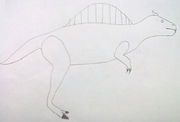
A possible restoration of a bison, restored as a super-predator of Pleistocene-Anthropocene North America.
All Todays bison is a formerly fictional outdated-looking bipedal theropod-like bison species, which can be either carnivorous, omnivorous, or herbivorous, depending on a species, that now exist in real life North America (along with real bison species).
All Todays description on bison[]
Fossils of these large land mammals have been found throughout North America and (possibly) Eurasia. Fossils of nearby larger bones suggests that these animals were about as big as an Albertosaurus/Gorgosaurus of the Mesozoic era, when these animals had died, making them the biggest carnivorous land animals of the Cenozoic era, filling the niche of other colossal land predators found elsewhere such as sharks. This animal could have lived in an environment colder than today, as evidenced by the site they were discovered in, which was filled with conifers and other cold-tolerant plants, so would have a form of cold tolerance for their bodies (blubber, fur, or feathers, etc) to keep them warm. Bison could have walked bipedally on hind legs due to their front legs being small yet strong, so their back legs were very strong. They were probably herbivorous or omnivorous, but there's no evidence of plant-eater teeth like molars or such similar teeth, instead there were probably sharp teeth found alongside bison skulls, so bison were most likely carnivorous, so they were probably either predators, scavengers, or even both. If carnivorous, their two clawed-fingered hands were likely sharp and strong, able to grab onto and slash their prey items. They had a tall sail on their backs probably used to scare off rivals or even used for body heat regulation to help keep their bodies cool or warm. They were probably covered in scaly skin, but their tails, backs (probably not their sails), sides, necks, and the backs of their heads could have been covered with either fur or feathers as some fossil impressions shows. Their hands could have been able to pronate like outdated non-avian theropod restorations as some fossil evidence of bison front legs suggests, but they probably didn't and their hands were most likely positioned in the same way as modern studies of non-avian theropod hands. They had horns on their heads, which were likely used during fights for mates (no matter if it's herbivorous, carnivorous, etc) or could have used them for ramming and injuring prey items (if omnivorous or carnivorous). They likely laid bowling ball-sized eggs, much like how birds and reptiles of today lay eggs, as evidenced by egg fossils bejng found near bison. The bison possibly lived for a century or more, probably about 100-370 years. It is unknown why the bison, the most powerful carnivore of North America, became extinct suddenly during the Anthropocene.
Introduction to real life North America[]
Since real life humans had introduced all todays bison to real life North America, these large bipedal bison of many species (scaly herbivores, scaly omnivores, scaly carnivores, furry herbivores, furry omnivores, furry carnivores, feathery herbivores, feathery omnivores, feathery carnivores, etc) now coexist alongside real bison species. Unlike their ancestors, even though the omnivorous and carnivorous ones remained aggressive towards any non-sapient non-dylanusid species, all kinds of all todays bison species are now peaceful to any sapient species/beings and to dylanusids, as they adapted into human settlements and learned to tolerate human activities and among others, so they now flourish alongside real bison species and are now very tame towards any sapient species.
